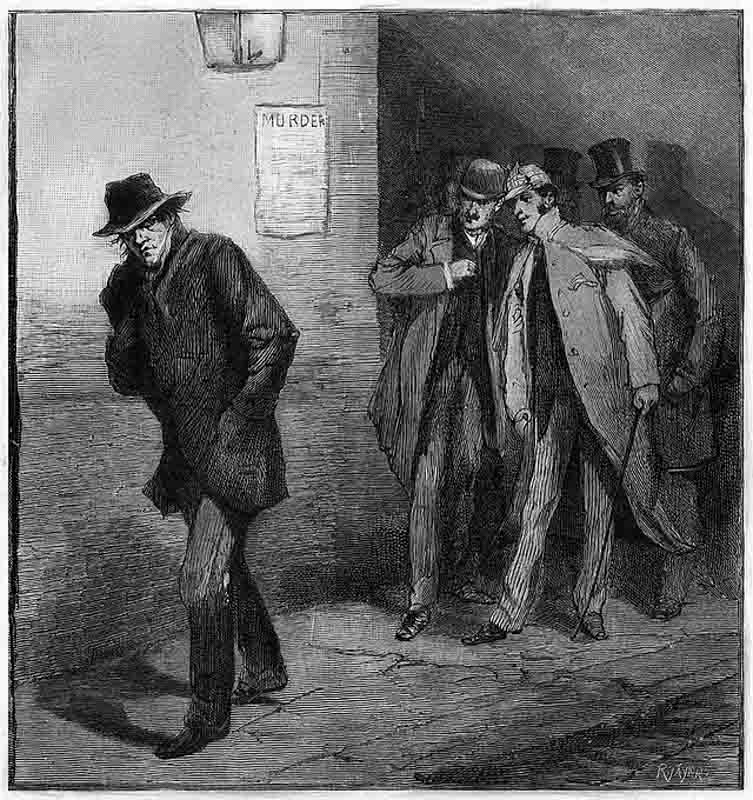London, 1888. A mysterious figure haunts the backstreets of Whitechapel. In time, his crimes would become something of legend, but for now, he is simply a known as Jack the Ripper.
His victims never suspected such a monster could be real. His penchant for violence and insatiable bloodlust is like something England has never seen before.
In this article, we're going to look at the Ripper's victims, the letters he sent to police and the numerous suspects who have cropped up over the years. Here's everything you need to know about Jack the Ripper.
Jack the Ripper's Victims
Jack the Ripper was officially only ever assumed to be responsible for five murders throughout Whitechapel in 1888, the victims of which were all sex workers.
Given that crime against women was fairly rampant during this time, similar murders occurred but many were not attributed to Jack due to different methodologies.
Although an umbrella term of the “Whitechapel murders” was coined to categorize similar attacks, there are a variety of theories regarding whether they were all carried out by the same person.
However, there exist the "Canonical Five" victims, all of which are universally acknowledged to have been committed by the same hand.
Mary Ann Nichols

Mary Ann Nichols is the first of the five canon Ripper victims. She was an alcoholic prostitute who was 44 years old at the time of her death.
In the early hours of the morning on 31 August 1888, Nichols's body was found on a roadside by a passerby.
Five of her teeth were missing, with additional cuts to the tongue. She had bruises along her lower jaw and to the left side of her face. She had severe lacerations to the neck and throat and an extended incision from jaw to ear. She had deep wounds along the lower side of her abdomen.
Annie Chapman
At around 6am on 8 September, 1888, the body of Annie Chapman was discovered in an alleyway.
Chapman was sprawled on the ground with her dress pulled over her knees. Her killer had sliced open her abdomen, removed her intestines and draped them over her shoulders in a bizarre display of theatrics.
An autopsy discovered that part Chapman's uterus had been removed. Her mouth and tongue were swollen, suggesting she had been beaten or strangled. The same slicing instrument had been used on both the throat and abdomen areas.
The coroner was convinced that the perpetrator possessed some knowledge of human anatomy, fuelling the speculation that Jack the Ripper could be a butcher, surgeon, doctor or medical assistant.
Elizabeth Stride
On the morning of 30 September 1888, the body of 44-year-old Elizabeth Stride was found outside a Working Men’s Club in Whitechapel.
When she was discovered by a steward at the worker’s club, Stride was still bleeding from an open wound in her neck, meaning that she'd been killed only minutes before the discovery.
In stark contrast to Mary Ann Nichols and Annie Chapman, Stride did not bear the hallmarks of a Jack the Ripper murder victim. While her throat had been deeply lacerated, post-mortem mutilation was absent.
It's believed that the steward who discovered Stride had interrupted Jack mid-murder, meaning he was unable to finish the job in full.
Catherine Eddowes

Not only was Catherine Eddowes the fourth victim of the Canonical Five, but she and Elizabeth Stride were committed on the same day, most likely within minutes of each other.
At 1:45am on 30 September, the severely mutilated corpse of Catherine Eddowes was found in an alleyway by a patrolling police officer. She had been killed by lacerations of the throat, the Ripper’s usual method of inflicting death.
Like Annie Chapman, Eddowes's intestines had been removed and draped across her shoulders. Her upper body had been severely lacerated, including her face, ears, nose, cheeks, eyelids, shoulders, neck and arms. Fecal matter had been smeared across her body.
A later autopsy on Eddowes revealed something very strange - the killer had removed her left kidney. This fuelled speculation even further regarding Jack's profession in the medical or butcher trade.
Mary Jane Kelly
The fifth and final of the canonical victims, the murder of Mary Jane Kelly added a further layer of mystery to the identity and motivations of the man known as Jack.
At the time of her murder, Kelly was only 24 years of age, pregnant (unconfirmed) and by many accounts, a beautiful woman. She was a prostitute by profession and at the time of her death, she was living in poverty.
On the morning of 9 November 1888, Kelly was discovered dead in her apartment by her landlord's assistant. She had been brutalized beyond recognition, suffering extreme mutilations, disfigurements and incisions which are considered excessive even by today's standards.
Kelly's murder marked the first time the Ripper had killed in private, which may explain why he pulverized her to such extreme lengths. Other theories state that Kelly and the Ripper were acquainted somehow and that this was a personal attack.
Jack The Ripper Case Letters

During the autumn of 1888, an estimated one thousand letters were received by both the London Metropolitan Police and press regarding information, details and advice on the Jack the Ripper case.
However, the majority were considered to be fake. But there were three letters in particular considered to be written by the genuine murderer.
The 'Dear Boss' Letter
First considered to be a hoax, the ‘Dear Boss’ letter was sent on September 27, 1888 to the Central News Agency in London and subsequently forwarded to Scotland Yard.
Do you think you know a serial killer? Check out these 11 common traits of a serial killer and find out!
The message was written in red ink and while the handwriting was largely competent, contained multiple spelling and punctuation errors. It was received just three days before the double murder.
The message alluded to “clipping the lady’s ears off,” which was a major significance. Three days after the letter was received, the corpse of Catherine Eddowes was found to have one of her earlobes cut off.
The 'Saucy Jack' Postcard
The day after the double murder on 1 October 1888, the press received further communication from someone referring to themselves as the murderer.
This time it was on a postcard, which was not only written in the same red ink with the same handwriting as the Dear Boss letter, but also appeared to have specs of blood on it.
“Number one squealed a bit but couldn’t finish straight off” being a reference to the fact that he was interrupted during Stride’s murder, meaning he wasn’t able to mutilate her to his intended degree.
The 'From Hell' Letter
Received by George Lusk of the Mile End Vigilance Committee, the ‘From Hell’ is memorable not just because of its mystery but because of what came attached with it. Along with the letter was a small parcel containing Catherine Eddowes's missing kidney.
The attachment of the kidney was almost conclusive proof that the ‘From Hell’ letter was written by the genuine murderer. Tests on the kidney did confirm that it was of human origin and from the left side of a female.
There were some most notable differences between the From Hell note and all previous correspondence from the killer, casting doubt on the legitimacy of all of them.
The literacy level in the From Hell Hell note was much lower than in other correspondance. It wasn't signed off as 'Jack the Ripper' like the previous two, and the handwriting was poor and almost child-like in its manner.
Jack The Ripper Suspects

Too many suspects, not enough bodies. That's the common slogan of Ripperologists the world over.
Indeed, there have been around 500 individuals put forward suspected of being the Whitechapel murderer, some more plausible than others.
Aaron Kosminski
In 2014, an amateur Ripperologist claimed that he had conclusive proof that a Polish barber named Aaron Kosminski was Jack the Ripper.
The evidence came in the form of a shawl that once belonged to Catherine Eddowes. The item was indeed genuine and was even still stained with Eddowes’s blood and the DNA of the person who murdered her.
Read Next: The World's Most Famous Serial Killers
The amateur Ripperologist claimed that DNA tests on the shawl proved that Aaron Kosminski had at least came into contact with it at some point, and was therefore likely to be Jack the Ripper.
Kominski had a history of insanity and was already considered by London Metropolitan Police to be a suspect around the late 19th century. However, it was found that Kominski's family were tailors, and may have passed DNA onto the shawl that way.
Sir William Gull
Possibly the most famous suspect, Sir William Gull was Queen Victoria's physician during the time of the Whitechapel murders.
The theory states that Prince Albert (the heir to the throne), had secretly married and impregnated a shop girl. The baby was then placed into the care of Mary Jane Kelly, the Ripper's final victim.

Gull and his fellow Freemasons are said to have killed prostitutes throughout London until they found Kelly and took the child.
This theory would indeed stack up as to how the Ripper murders played out. The sheer overkill inflicted on Mary Jane Kelly suggests a personal connection between victim and killer, and it was unlike any other Ripper attack.
Francis Tumblety
Francis Tumblety was a conman who posed as an “Indian herb doctor” in the US and Canada. Tumblety was in England during the Whitechapel murders and was known for acts of misogyny and charlatanism around the East End of London.
Tumblety was forced out of his home in Boston after authorities accused him of malpractice with his patients and managed to avoid convinction.
He then arrived in England in mid-1888 and was arrested again for homosexuality. Tumblety also boasted to his friends of having a collection of wombs from “every class of woman” in his possession.
Unfortunately, while Tumblety was under suspicion of being the Ripper during his arrest, Mary Jane Kelly's murder took place, effectively declaring him innocent. Although after Tumblety’s death in 1903, police discovered a collection of preserved foetuses in his lodging house.
Conclusion
More than a century has passed since the Whitechapel murderer took the lives of London women and left a trail of blood, body parts and vital organs in his wake. Yet, despite the efforts of thousands of Ripper enthusiasts, we are still no closer to uncovering the truth.
Is the Ripper’s identity destined to remain a secret which no living soul will ever know? Will he be a phantom for the rest of time; a nameless silhouette in the shadows?
Despite over 130 years of investigation, speculation and research, it's likely that the murders of Jack the Ripper will remain unsolved forever.
FAQS
Who was Jack the Ripper?
Jack the Ripper was a 19th century serial killer who targeted sex workers in London's East End. He was responsible for the deaths of at least five women.
How many people did Jack the Ripper kill?
Jack the Ripper's official victim count lies at 5 (the Canonical Five), but some theories state that Jack could have been responsible for several more.
How did Jack the Ripper kill his victims?
Jack the Ripper stabbed his victims with a butcher's knife and then lacerated them to various degrees.
How did Jack the Ripper die?
Unknown. The identity of Jack the Ripper remains a mystery, and therefore his fate is unknown.
Where was Jack the Ripper from?
Unknown. Jack the Ripper's identity has never been uncovered, so it's impossible to say where he was from. However, given that his committed all of his murders in Whitechapel, London, it's probable that he lived in or around the same area.
When was Jack the Ripper active?
Jack the Ripper was active between August and November 1888. Despite his legacy and notoriety, Jack only killed during this short period.
Who did Jack the Ripper kill?
Jack the Ripper killed five women; Mary Ann Nichols, Annie Chapman, Elizabeth Stride, Catherine Eddowes, and Mary Jane Kelly. These Ripper victims are known as the Canonical Five.
How did Jack the Ripper get his name?
During the Jack the Ripper murders in 1888, a letter was received by the Central News Agency in London. It was supposedly written by the killer himself, and he had signed off with the signature ‘Jack the Ripper’.
When was Jack the Ripper alive?
Unknown. No personal information about Jack the Ripper is known as his identity remains a mystery. However, he was theorized to be in his twenties during his killing spree, so it's likely he was born between 1859 and 1868.
Why is Jack the Ripper so famous?
Jack the Ripper gave birth to the modern lust killer as we know it today. The predator who stalks the shadows, the vengeful monster who targets sex workers, the mastermind who taunts police with letters and calls. This is one of the many reasons the Ripper's crimes are still discussed today. In fact he's so famous that there's even a Jack The Ripper t-shirt.
Now that you know more about Jack the Ripper check out our true crime shirts and then read about Ted Bundy, the most famous serial killer in history.













1 comment
Kate Bishop
I will always think that Jack the Ripper is interesting because of how he was never caught. Sometimes I even wonder if the reason he was never caught is because it was a woman who made the public think that she was a man so she would never be caught. but that is just one of people’s many theories